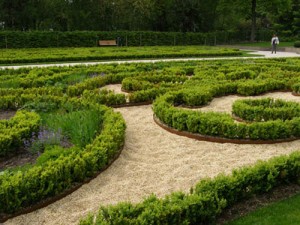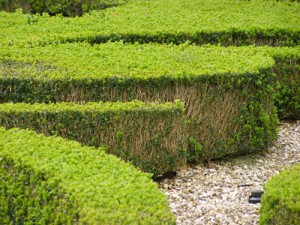Steel has become a popular gardening material in recent years, as for instance gardenvisit.com noted during the 2010 Chelsea Flower Show. Sculptures, seats, anything can be done in steel (a few months ago I saw an original early 20th century agave-in-pot, completely made of zinc).
Corten steel.
In Chelsea corten steel (also known as weathering – or COR-TEN steel) was also used for sculptures, but the material has been around for a while in gardens -with a different use. Many parterres de broderie have in recent years been (re)created within the curves of narrow strips of corten steel, dividing the planted areas from the ones containing gravel. Plant box hedges within the boundaries, pour gravel in the remaining areas and hey presto: we can still see the steel.

Corten Steel edging in Het Park, Rotterdam. Photo by HvdE.
The fact that the steel strips are often clearly visible irritates me, because it is ugly and unnecessary. The only funcions of the steel in these layouts are: divide the areas and contain materials. Skilled gardeners should be able to mask the divider by keeping it hidden, just under ground level. And thus create the illusion that what we see is the result of meticulous maintenance.
I do not need to be shown how the parterre was created, I just want to see and enjoy the combined materials this garden element is supposed to be made of: plants and gravel.
Corten Steel edging at Het Loo, Apeldoorn. Photo by HvdE.
The parterres at Het Loo show that it is possible to use corten steel and achieve an aesthetically acceptable picture -although they probably could clip the hedges a bit less harsh. The high edges of steel that are clearly visible in the parterres of the ‘Dutch Garden’ in Het Park in Rotterdam (created in 1960, restored in 2009) again show how bad execution can ruin a good idea.




In my opinion, in the Het Park image, the fact that the gravel is not raked level is as much of a visual deterrent as the metal edging. As the planting is still very young, compared to your other images, the edging stands out visually even more. The soil level looks like it can’t be lowered because of the planting, so no lowering of the metalwork. I’d recommend one of two things: Raise the level of the gravel slightly (raked preferably) or wait for the hedges to develop in width and conceal the edging. In managing a garden, I could not justify the material choice or expense of corten steel only to sink it below ground level!
Regarding the Het Loo image, Buxus regenerates and responds very well to hard pruning, will need this from time to time to keep the ever changing plants to the design intent, and for a hedge that size it has probably filled back by now. I’m restoring original C19 box hedging and have had to reduce its width by 30-50 cm in places. It’s responding well and is almost completely back in shape in just a few years.
Both issues could have been mitigated by some form of interpretative signage. If garden visitors understand what Het Park is intended to look like in ten years time, or how periodic, renovative pruning is required for established, older hedges, the temporary and subjective impact could be addressed.
Where appropriate, using smaller plants (potentially propagated from historic material) or renovating what plants you have, is far more sustainable and helps retain horticultural skills that are vital to the long-term care of historic gardens. Admittedly, horticulturists could sometimes communicate this better and explain what they are trying to achieve and on what time-scale. This is especially necessary where public expectation is driven by Chelsea show gardens or mainstream garden media, using expensive, often imported mature plants (with the pest and disease risks associated with this) built to unrealistic time-scales.